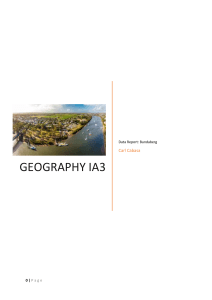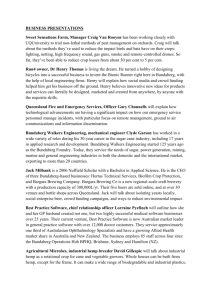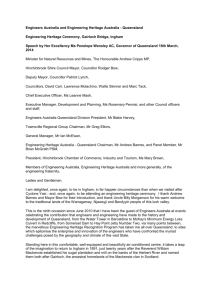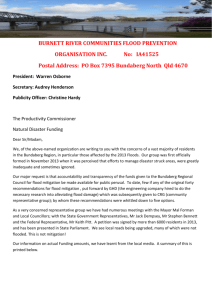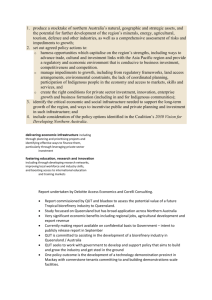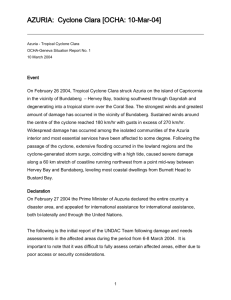Her Excellency Ms Penelope Wensley AO, Governor of Queensland
advertisement
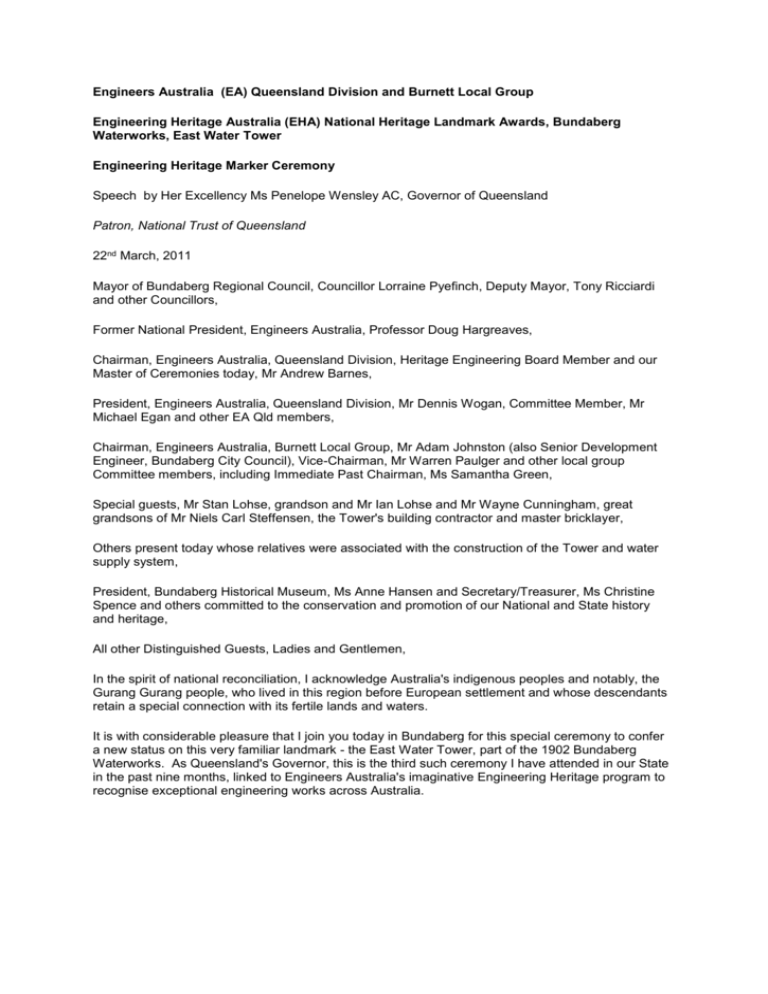
Engineers Australia (EA) Queensland Division and Burnett Local Group Engineering Heritage Australia (EHA) National Heritage Landmark Awards, Bundaberg Waterworks, East Water Tower Engineering Heritage Marker Ceremony Speech by Her Excellency Ms Penelope Wensley AC, Governor of Queensland Patron, National Trust of Queensland 22nd March, 2011 Mayor of Bundaberg Regional Council, Councillor Lorraine Pyefinch, Deputy Mayor, Tony Ricciardi and other Councillors, Former National President, Engineers Australia, Professor Doug Hargreaves, Chairman, Engineers Australia, Queensland Division, Heritage Engineering Board Member and our Master of Ceremonies today, Mr Andrew Barnes, President, Engineers Australia, Queensland Division, Mr Dennis Wogan, Committee Member, Mr Michael Egan and other EA Qld members, Chairman, Engineers Australia, Burnett Local Group, Mr Adam Johnston (also Senior Development Engineer, Bundaberg City Council), Vice-Chairman, Mr Warren Paulger and other local group Committee members, including Immediate Past Chairman, Ms Samantha Green, Special guests, Mr Stan Lohse, grandson and Mr Ian Lohse and Mr Wayne Cunningham, great grandsons of Mr Niels Carl Steffensen, the Tower's building contractor and master bricklayer, Others present today whose relatives were associated with the construction of the Tower and water supply system, President, Bundaberg Historical Museum, Ms Anne Hansen and Secretary/Treasurer, Ms Christine Spence and others committed to the conservation and promotion of our National and State history and heritage, All other Distinguished Guests, Ladies and Gentlemen, In the spirit of national reconciliation, I acknowledge Australia's indigenous peoples and notably, the Gurang Gurang people, who lived in this region before European settlement and whose descendants retain a special connection with its fertile lands and waters. It is with considerable pleasure that I join you today in Bundaberg for this special ceremony to confer a new status on this very familiar landmark - the East Water Tower, part of the 1902 Bundaberg Waterworks. As Queensland's Governor, this is the third such ceremony I have attended in our State in the past nine months, linked to Engineers Australia's imaginative Engineering Heritage program to recognise exceptional engineering works across Australia. The program is very exacting in its requirements - recognition is not easily conferred - and from the outset I thank and congratulate those who took on the task, who completed the detailed work involved in putting the nomination submission together: former Bundaberg City Council Engineer and Engineers Australia - Local Burnett Group Member, Mr Geoff Bullpit and Mr Aaron Kelly of the Bundaberg Regional Council. I read the submission in its entirety and, as a layman, albeit one with a keen interest in our Queensland history and heritage, I found it not only fascinating but highly persuasive - as obviously did the expert members of the Heritage panel. It is interesting that all three of the ceremonies I have attended to date have celebrated engineering feats relating to water: systems to store it and mitigate flooding (the Somerset Dam); means of crossing it (the Burdekin Bridge); and now, with the Bundaberg Waterworks and its East Tower, systems to distribute it. Interesting, but not surprising, given the great challenge that water management represents for all Australians, living as we do on the oldest, flattest and driest of the earth's inhabited continents. Of course, we in Queensland in recent months have had more than enough of it, with our summer of storms, floods and Cyclone Yasi and the devastation these events have caused for so many people and so many communities - including here in Bundaberg and the surrounding region. Although the recovery is underway, for many, the pain is far from over and probably the last thing they want to be reminded about - or think about - is water. Yet we all know how vital it is - and against the background of having endured almost a decade of drought before this last summer, there are few Queenslanders, I would wager, who could fail to appreciate the critical importance of having not just good systems, but the best possible systems to manage it. Certainly, the good citizens of Bundaberg identified the need for such systems very early in the piece. In the 1870's, when it was just a small community of 500 persons, a proper water reticulation system was seen as a high priority, it being argued that there was no water pressure to fight fires, that household water had to be hand carted and that there was no means to keep the road dust at bay. Luckily, involved at an early stage was one of Australia's great water engineers - whose name has already been mentioned by Michael Egan, in his informative presentation - John Baillie Henderson, the resident engineer of Queensland's northern waterworks, who in 1883 occupied the new office of Government Hydraulic Engineer. (He was a remarkable man. Among other things ‘Hydraulic Henderson' as he became known, was the first to explore the theory and potential of artesian water in Queensland and was the first to recommend government control of artesian water in order to conserve the precious resource. Records show he traveled thousands of miles throughout Queensland in his work and was the first to introduce the gauging of rivers, thereby providing the tools for the first flood warning system in Queensland - a topical subject today! In 1904 he was even briefly responsible for the State's first weather bureau.) Those citizens of Bundaberg had to wait a decade - until the mid 1880s, by which time the town had increased six fold to 3,000 and had gained municipal council status, before Henderson was able to draw up plans and costings for a water supply system. At the end of the 1880s, by which time the proposal had been advanced for a large water tower, as the centrepiece of the new system, that cost was estimated to be 7,000 pounds. But then came planning and financial problems and the economic depression of the 1890s - problems that will sound not unfamiliar to Madam Mayor and the Bundaberg Regional Councillors - which held up progress for more than a decade and it was not until 1896 that Henderson returned to revive plans for a water supply for a town whose population by then had reached 4000; and, again no surprise to anyone in today's audience, I suspect, the cost had blown out from that earlier estimate of 7,000 to almost three times that amount, to around 20,000 pounds! It's a wonder the money was ever secured and the project able to proceed, but eventually, the records show, the funds were provided as a loan from the State Government's consolidated revenue. Those same records also showed that the design of the centrepiece of the reticulation system - this magnificent water tower - was produced by Henderson and two of his staff - Charles Deshon and Frederick Weber. Henderson, however, does seem to have been something of a perfectionist and the cause of a number of repeated delays in getting the final plans adopted. Some at the time may have complained about his fussiness, but as a perfectionist myself, I am sympathetic, and looking at this tower now, well over a century later, the dividends of Henderson's perfectionism are evident in its longevity and the fact that it is, I am informed, still a functioning part of the water reticulation system albeit currently being rested. The dividends of his creativity also, are evident in its graceful Italianate lines. He has managed, it might be said, to make it more simple and more aesthetically pleasing than the Leaning Tower of Pisa (if we ignore the water tank) and certainly vastly more structurally sound and as such, it has become a unique monument of engineering design and thus a landmark well deserving of its heritage recognition. And if that were not sufficient to gain that formal recognition, its social assets add a further appeal and actually formed part of the claims in the submission. Although I haven't seen this for myself, the 80 years of overlaid graffiti inside the tower apparently is a remarkably rich record of the literary skills of many young children (and possibly of some slightly older local residents as well!) and a touching library of lovers' odes. Whatever people may find pleasing about this Water Tower - its rich history, the ingenuity of its design, the skills involved with its construction, the appealing symmetry of its appearance, its continued functionality more than a century after it was built - it all adds up to a remarkable feature, not only of the Bundaberg landscape, but of our national landscape and it is thus with great pride that Queenslanders should welcome the recognition being conferred on it today by Engineers Australia and the Engineering Heritage Program. I thank them for this recognition, as I thank and congratulate everyone involved with the process by which it was achieved and with the organisation of today's ceremony. And it is now, with great pleasure, that I join Bundaberg Regional Council Mayor, Lorraine Pyefinch and Engineers Australia - Local Burnett Group Chairman, Mr Adam Johnson, in unveiling this Heritage Plaque which proclaims the Bundaberg East Water Tower, of the Bundaberg Waterworks 1902, to be an Engineering Heritage Landmark. Downloaded on 8 Dec 2014 from http://web.archive.org/web/20140225005604/http://www.govhouse.qld.gov.au/the_governor/speeches _articles.aspx
